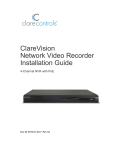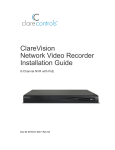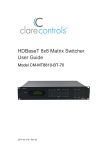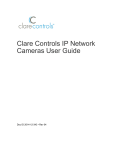Download Clare Controls ClareVision Installation guide
Transcript
ClareVision Network Video Recorder Installation Guide Model CV-M321620-08 Doc ID 2015-01-622 • Rev 02 Copyright © 13JAN15 Clare Controls, Inc. All rights reserved. This document may not be copied in whole or in part or otherwise reproduced without prior written consent from Clare Controls, Inc., except where specifically permitted under US and international copyright law. Trademarks The ClareVision name is a trademark of Clare Controls, Inc. Other trade names used in this document may be trademarks or registered trademarks of the manufacturers or vendors of the respective products. Version Contact information This document applies to CV-M32810-08 ClareVision Network Video Recorder Rev 2.0. For contact information, see www.clarecontrols.com. Note: The figures shown in this manual are for reference only. The appearance and interface of the device are subject to the actual model. Content Package contents...1 NVR pre-installation...1 NVR installation...1 Hard disk installation (optional)...2 Front panel...4 Rear panel...7 Peripheral connections...8 Wiring of alarm input...8 Wiring of alarm output...8 Using of alarm connectors...9 Controller connection...9 HDD storage calculation chart...10 Menu operation...11 Startup and shutdown...11 Using the Setup Wizard...12 Live View...15 Adding and configuring IP cameras...15 Configuring basic parameters of IP cameras...16 PTZ control...18 PTZ settings...18 PTZ control...18 Playback...19 Instant playback by channel...19 Playback by channel...20 Backup...21 Understanding camera capacity in an NVR...23 Streaming video types...23 Adjusting settings...24 Specifications...25 ClareVision Network Video Recorder Installation Guide i ii ClareVision Network Video Recorder Installation Guide Package contents 1 X 32 channel NVR appliance 1 X AC power cord 1 X optical mouse 1 X remote control 2 X rack mount ears 16 X mounting screws 1 X SATA hard drive cable NVR pre-installation This NVR is highly advanced surveillance equipment that should be installed with care. Please take into consideration the following precautionary steps before installation of the NVR. • Keep all liquids away from the NVR. • Install the NVR in a well-ventilated and dust-free area. • Ensure environmental conditions meet factory specifications. • Install a manufacturer recommended HDD. NVR installation When installing the NVR: • Use brackets for rack mounting. • Ensure that there is ample room for audio and video cables. • When routing cables, ensure that the bend radius of the cables is no less than five times its diameter. • Connect both the alarm and RS-485 cable. (Optional) • Allow at least .75 in. (2 cm) of space between racks mounted devices. • Ensure the NVR is grounded. • Environmental temperature should be within the range of 14 to 131 ºF (-10 to 55 ºC). • Environmental humidity should be within the range of 10 to 90%. ClareVision Network Video Recorder Installation Guide 1 Hard disk installation (optional) Additional SATA hard disks can be installed in your NVR. Disconnect the power from the NVR before installing a hard disk drive (HDD). A factory recommended HDD should be used for this installation. Up to 8 SATA hard disks can be installed on your NVR. Tools required: Philips head screwdriver. To install the hard disk drive into the NVR: 1. Remove the cover from the NVR by unfastening the screws on the back and side panel. When installing a SATA hard disk drive, we recommend that the installer wear anti-static gloves and a grounding wrist-strap. 2. Connect one end of the data cable to the motherboard of the NVR and the other end to the HDD. 3. Connect the power cable to the HDD. 2 ClareVision Network Video Recorder Installation Guide 4. Place the HDD on the bottom of the device, and then fasten the screws on the bottom to attach the HDD. ClareVision Network Video Recorder Installation Guide 3 Front panel No. Name Setting Function Description 1 Status indicators POWER Turns green when NVR is powered up. READY The LED is green when the device is running normally. STATUS The light is green when the IR remote control is enabled. The light is red when the function of the composite keys (SHIFT) are used. The light is out when none of the above conditions are met. 2 DVD-R/W 3 Control buttons ALARM The light is red when there is an alarm occurring. HDD Blinks red when HDD is reading/writing. Tx/Rx Blinks green when network connection is functioning normally. Slot for DVD-R/W DIRECTION In Menu mode, the direction buttons are used to navigate between different fields and items and select setting parameters. In Playback mode, the Up and Down buttons are used to speed up and slow down record playing, and the Left and Right buttons are used to move the recording 30s forwards or backwards. In the image setting interface, the Up and Down button can adjust the level bar of the image parameters. In Live View mode, these buttons can be used to switch channels. ENTER The Enter button is used to confirm selection in menu mode; or used to check checkbox fields and ON/OFF switch. In Playback mode, it can be used to play or pause the video. In Single-frame Play mode, pressing the Enter button will play the video by a single frame. In Auto Sequence View mode, the buttons can be used to pause or resume auto sequence. 4 ClareVision Network Video Recorder Installation Guide No. Name Setting Function Description 4 Composite keys SHIFT Switch between the numeric or letter input and functions of the composite keys. (Input letter or numbers when the light is out; Realize functions when the light is red.) 1/MENU Enter the numeral “1” Access the main menu interface. 2/ABC/F1 Enter the numeral “2”. Enter the letters “ABC”. The F1 button when used in a list field will select all items in the list. In PTZ Control mode, it will turn on/off PTZ light and when the image is zoomed in, the key is used to zoom out. 3/DEF/F2 Enter the numeral “3”. Enter the letters “DEF”. The F2 button is used to change the tab pages. In the PTZ control mode, it zooms in the image. 4/GHI/ESC Enter the numeral “4”. Enter the letters “GHI”. Exit and back to the previous menu. 5/JKL/EDIT Enter the numeral “5”. Enter the letters “JKL”. Delete characters before cursor. Check the checkbox and select the ON/OFF switch; Start/stop record clipping in playback. 6/MNO/PLAY Enter the numeral “6”. Enter the letters “MNO”. Playback, for direct access to playback interface. 7/PQRS/REC Enter the numeral “7”. Enter the letters “PQRS”. Open the manual record interface. 8/TUV/PTZ Enter the numeral “8”. Enter the letters “TUV”. Access the PTZ control interface. 9/WXYZ/PREV Enter the numeral “9”. Enter the letters “WXYZ”. Multi-channel display in live view. 0/A Enter the numeral “0”. Shift the input methods in the editing text field. (Upper and lowercase, alphabet, symbols or numeric input). Double press the button to switch the main and auxiliary output. ClareVision Network Video Recorder Installation Guide 5 No. Name Setting 5 JOG SHUTTLE control Function Description Move the active selection in a menu. It will move the selection up and down. In Live View mode, it can be used to cycle through different channels. In the Playback mode, it can be used to jump 30 seconds forward/backward in video files. In the PTZ control mode, it can control the movement of the PTZ camera. 6 POWER ON/OFF Power on/off switch. 7 USB interfaces Universal Serial Bus (USB) ports for additional devices such as USB mouse and USB Hard Disk Drive (HDD). 6 ClareVision Network Video Recorder Installation Guide Rear panel (2) (1) (3) (4) (5) (6) (7) SW RS-485 ON KB ALARM IN ALARM OUT eSATA 1 2 3 4 5 6 7 8 9 10 11 12 13 14 15 16 (8) (9) (10) (11) (12) (13) (14) (15) No. Item Description 1 eSATA (Optional) Connects an external hard drive. 2 RS-232 Interface Connector for the RS-232 devices. 3 VIDEO OUT BNC connector for the video output. 4 VGA VGA output 15 pin connector. Displays the local video output and the menu. 5 LINE IN BNC connector for the audio input. 6 Termination Switch RS-485 termination switch. The up position is not terminated. The down position is terminated with 120 Ω resistance. 7 RS-485 Interface Connector for the RS-485 devices. The T+ and T- pins connect to the R+ and R- pins of the PTZ receiver respectively. Controller Port The D+, and the D- pin connects to the Ta, and the Tb pin of the controller. For cascading devices, the first NVR’s D+, D- pin should be connected with the D+, D- pin of the next NVR. ALARM IN Connector for alarm input. ALARM OUT Connector for alarm output. 8 Network Interfaces with PoE Network interfaces for the cameras and to provide power over function Ethernet (PoE). 9 CVBS AUDIO OUT BNC connector for the audio output. This connector is synchronized with the CVBS video output. VGA AUDIO OUT BNC connector for the audio output. This connector is synchronized with the VGA video output. 10 HDMI HDMI video output for the connector. 11 USB interface Universal Serial Bus (USB) ports for additional devices such as USB mouse and USB Hard Disk Drive (HDD). 12 LAN Interface One network interface provided. 13 GROUND Ground (must be connected when the NVR starts.) 14 AC 100 V to 240 V AC 100 V to 240 V power supply. 15 POWER Switch for turning the device on/off. ClareVision Network Video Recorder Installation Guide 7 Peripheral connections Wiring of alarm input The alarm input is an open/closed relay. To connect the alarm input to the device, use the following diagram. Note: If the alarm input is not an open/close relay, connect an external relay between the alarm input and the device. RS-485 KB ALARM OUT ALARM IN Alarm Input Alarm Input Alarm Output Alarm Output Wiring of alarm output To connect to an alarm output (AC or DC load), use the following diagram. DC Load Connection Diagram AC Load Connection Diagram For the DC load, the jumpers can be used within the limit of 12V/1A safely. To connect an AC load, jumpers should be left open (you must remove the jumper on the motherboard in the NVR). Use an external relay for safety (as shown in the figure above). There are four jumpers (JP1, JP2, JP3, and JP4) on the motherboard, each corresponding to one alarm output. By default, jumpers are connected. To connect an AC load, the jumpers should be removed. 8 ClareVision Network Video Recorder Installation Guide Example: If you connect an AC load to the alarm output 3 of the NVR, then you must remove the JP3 jumper. Using of alarm connectors To connect alarm devices to the NVR: 1. Disconnect the terminal block from the ALARM IN /ALARM OUT port. 2. Unfasten the stop screws from the terminal block, insert the signal cables into the slots, and then fasten the stop screws. Ensure the signal cables are tight. 3. Connect the terminal block back into the port. Controller connection SW RS-485 ON ALARM IN ALARM OUT eSATA 1 2 3 4 5 6 7 8 9 10 11 12 13 14 15 16 NVR RS-485 To connect a controller to the NVR: 1. Disconnect the terminal block from the port. 2. Unfasten the stop screws from the D+, D- terminal block, insert the signal cables into the slots, and then fasten the stop screws. Ensure the signal cables are in tight. 3. Connect Ta on the controller to D+ on the terminal block and Tb on the controller to D- on the terminal block. Fasten the stop screws. 4. Connect the terminal block back into the port. Note: Make sure both the controller and NVR are grounded. ClareVision Network Video Recorder Installation Guide 9 HDD storage calculation chart The following chart shows an estimation of storage space used based on recording at one channel for an hour at a fixed bit rate. Table 1: Storage calculation chart Bitrate Storage Used 96 K 42 M 128 K 56 M 160 K 70 M 192 K 84 M 224 K 98 M 256 K 112 M 320 K 140 M 384 K 168 M 448 K 196 M 512 K 225 M 640 K 281 M 768 K 337 M 896 K 393 M 1024 K 450 M 1280 K 562 M 1536 K 675 M 1792 K 787 M 2048 K 900 M 4096 K 1800 M 8192 K 3600 M 16384 K 7200 M Note: The values supplied for the storage space used is only for reference. The storage values in the chart are estimated by formulas and may be different from the actual value. 10 ClareVision Network Video Recorder Installation Guide Menu operation Startup and shutdown Proper startup and shutdown procedures are crucial to expanding the life of the NVR. To start your NVR: 1. Connect to a monitor using VGA or HDMI. 2. Check that the power supply is plugged into an electrical outlet, and then flip the rear power switch to ON. We highly recommend that you use an Uninterruptible Power Supply (UPS) in conjunction with the device. 3. Press the POWER button on the front panel. The Power LED turns green as the unit starts. To shut down the NVR: 1. Enter the Shutdown menu (Menu > Shutdown). 2. Select Shutdown. 3. Click Yes. ClareVision Network Video Recorder Installation Guide 11 Using the Setup Wizard By default, the Setup Wizard starts once the NVR has loaded. To operate the Setup Wizard: 1. The Setup Wizard can walk you through some important settings of the NVR. If you don’t want to use the Setup Wizard at this time, click Cancel. You can also choose to use the Setup Wizard the next time by selecting the Start wizard when device starts? checkbox. 2. Click Next on the Wizard window to enter the Login window. 3. Enter the admin username and password. The default username is “clareadmin”; the default password is “secure7”. 4. To change the admin password, select the New Admin Password checkbox. Enter the new password and confirm the password in the given fields. Note: We strongly recommend changing the admin password on initial use. Record this password in a safe place, if lost the NVR will require a factory reset. 5. Click Next to enter the date and time settings window. 12 ClareVision Network Video Recorder Installation Guide 6. Enter the correct time zone, date, and time for your location in their corresponding fields. 7. After the time settings, click Next to enter the Network Setup window. The internal NIC IPv4 address should be configured for the cameras connecting to the PoE network interface of the NVR. 8. Click Next to enter the HDD Management window. ClareVision Network Video Recorder Installation Guide 13 9. To initialize the desired HDD, click Init. Initialization removes all the data saved in the HDD. Note: The HDDs are initialized in the factory and are ready to record out of the box. 10. Click Next. You will enter the Adding IP Camera interface. 11. Click Search to find online IP Camera. 12. Select the IP camera to be added, and then click Add. 13. Click the Next button. Configure the recording settings for the searched IP Cameras. 14. Click Copy to copy the settings to other channels. 14 ClareVision Network Video Recorder Installation Guide 15. Click OK to complete the Setup Wizard and return to Live View. Live View Some icons are provided on the screen in Live View mode to indicate different camera status. Icons appear at the top right of the screen for each channel. They show the status of the record and alarm in the channel so that you can identify problems quickly. Table 2: Live View icons Icon Description Alarm (video loss, tampering, motion detection or sensor alarm) Record (manual record, schedule record, motion detection or alarm triggered record) Alarm & Record Adding and configuring IP cameras Add and configure the online IP cameras to enable the Live View and recording function. You can search and add the online IP cameras by following the Startup wizard, or by following these steps. To add IP cameras: 1. Right click to enter the Camera Management interface (Menu > Camera > Camera). ClareVision Network Video Recorder Installation Guide 15 To add the online cameras with same network segment: 1. Click Search to search the online cameras. 2. Select the checkboxes for the cameras to be added. 3. Click Quick Add to add the cameras. To add other IP cameras: 1. In the left side of the window, enter the IP address, protocol, management port, and other information for the IP camera. 2. Click Add to add the camera. Configuring basic parameters of IP cameras After the adding the IP camera, the basic information displays on the page. You can configure the basic parameters of the IP camera. 16 ClareVision Network Video Recorder Installation Guide Table 3: Basic icons Icon Description Edit basic parameters of the camera Delete the IP camera Get the live view of the camera To configure basic parameters: 1. Click the icon to edit the parameters. You can edit the IP address, protocol, and other parameters. 2. Click Apply to save the settings, and then click OK to exit the editing interface. To edit more parameters: 1. Click the Advance Set icon. ClareVision Network Video Recorder Installation Guide 17 2. You can edit the network information and the password of the camera. 3. Click Apply to save the settings, and then click OK to exit the interface. PTZ control Before you begin, ensure the PTZ is properly connected to the NVR through the RS-485 interface. PTZ settings To set PTZ: 1. Enter the PTZ Settings interface (Menu > Camera > PTZ). 2. In the Camera drop-down menu, select the camera for the PTZ setting. 3. Enter the parameters of the PTZ camera. Note: All the parameters should match the PTZ camera parameters. 4. Click Copy if you want to copy the same settings to other PTZ cameras. 5. Click Apply to save and exit the interface. PTZ control In the Live View mode, press the PTZ Control button on the front panel or on the remote, or choose the PTZ Control icon to enter the PTZ panel. 18 ClareVision Network Video Recorder Installation Guide Table 4: PZT control icons Icon Description Direction button and the auto-cycle button The speed of the PTZ movement 3D-Zoom Patrol Previous item Stop the patrol or pattern movement Zoom+, Focus+, Iris+ Light on/off Image Centralization Pattern Next item Minimize windows Zoom-, Focus-, IrisWiper on/off Preset Menu Start pattern/patrol Exit Playback Play back the record files of a specific channel in the Live View menu. Instant playback by channel Choose a channel under Live View using the mouse, and then click the in the shortcut operation menu. button Note: Only the record files recorded during the last five minutes on this channel will be played back. ClareVision Network Video Recorder Installation Guide 19 Playback by channel To playback by channel: 1. Enter the Playback menu. Mouse: Right-click a channel in Live View mode and select from the menu. Front Panel: Press PLAY to play back the record files of the channel under single-screen live view. Under multi-screen live view, record files of the selected channel will be played back. Note: Pressing numerical buttons will switch playback to the related channels for the playback process. Playback management The toolbar in the bottom part of Playback interface can be used to control the playback process. 20 ClareVision Network Video Recorder Installation Guide Check the channel or channels if you want to switch playback to another channel, or execute simultaneous playback of multiple channels. Backup Recorded files can be backed up to various devices, such as USB flash drives, USB HDDs, or a DVD writer. To back up recorded files: 1. Enter the Video Export interface (Menu > Export > Normal). 2. Select the channel(s) you want to back up, set the search condition, and then click Search to enter the search result interface. 3. In the Search Result interface, select the record files you want to back up, and then click Export. 4. Enter the Export interface, choose a backup device, and then click Export to start exporting. ClareVision Network Video Recorder Installation Guide 21 Note: You can choose to export the record file(s) and the related log file(s), or the player. 5. Check the backup results. Choose the record file in the Export interface, and then press to check it. 22 ClareVision Network Video Recorder Installation Guide Understanding camera capacity in an NVR When setting up your NVR and cameras, you may notice that some of the camera images may not display in Live View. This most often occurs when you are displaying images in 1+5 mode, or 1+7 mode because the total bit rate for all cameras is exceeding the NVR’s capacity. The actual capacity depends on the total bit rate from all the cameras. However, it is good practice to allow some headroom for machine operations, such as remote streaming. NVR model Capacity 4-channel 20 Mb 8-channel 40 Mb 16-channel 80 Mb 32-channel 160 Mb 64-channel 160 Mb To fully understand NVR capacity, it is necessary to understand the concepts of streaming video, resolution, quality, and bit rate. Streaming video is content sent in compressed form over a network and processed in real time, that is, as it is received. Streaming video types • Main Stream: the high quality video that is being recorded and may be streamed. • Sub Stream: never recorded; intended for streaming only. Default is 704 × 480, 584 Kbps at 8 fps. • Can be video alone, or video and audio compressed together. Audio requires very little bandwidth. The combination of the main stream and sub streams make up the total bit rate of each camera. This is expressed in Kbps (kilobits per second) or Mbps (megabits per second). Bit rate is determined by the selected resolution (1280 × 720, 1920 × 1080, 2560 × 1920, etc.), frame rate (frames per second), and video quality (the amount of compression being applied to each camera). Example 32 channels of 720P cameras at 15 fps with good image quality will have 32 x (1536 + 512) = 65536 Kbps (about 66Mbps), so the 32-channel NVR can support them. ClareVision Network Video Recorder Installation Guide 23 Each channel can support a different camera, as long as they do not exceed the total bit rate limit. It is entirely possible to mix 5 MP cameras with 4CIF IP cameras, etc. Generally, 5 MP at 30 fps requires around 20 Mbps for best quality. A 4-channel NVR is currently limited to 16 Mbps. Adjusting settings Be aware of your NVR’s capacity and make adjustments, if necessary. Adjust the bit rate by lowering the resolution, frame rate, or video quality setting. To adjust the setting: 1. Enter the Live View settings interface. 2. Adjust the Resolution, Frame Rate, and Video Quality settings. 24 ClareVision Network Video Recorder Installation Guide Specifications Video/Audio input Video/Audio output IP video input 32-ch Two-way audio 1-ch, BNC (2.0 Vp-p, 1k Ω) Recording resolution 5 MP /3 MP /1080P /UXGA /720P /VGA /4CIF /DCIF /2CIF /CIF /QCIF Frame rate Main stream: 25 fps (P) / 30 fps (N) Sub-stream: 25 fps (P) / 30 fps (N) CVBS output 1-ch, BNC (1.0 Vp-p, 75 Ω) Resolution: 704 × 576 (PAL); 704 × 480 (NTSC) HDMI output 1-ch, resolution: 1920 × 1080P / 60 Hz, 1920 × 1080P / 50 Hz, 1600 × 1200 / 60 Hz, 1280 × 1024 / 60Hz, 1280 × 720 / 60 Hz, 1024 × 768 / 60 Hz VGA output 1-ch, resolution: 1920 × 1080P / 60 Hz, 1600 × 1200 / 60 Hz, 1280 × 1024 / 60 Hz, 1280 × 720 / 60 Hz, 1024 × 768 / 60 Hz Audio output 2-ch, BNC (Linear, 600 Ω) Playback resolution 5 MP /3 MP /1080P /UXGA /720P /VGA /4CIF /DCIF /2CIF /CIF /QCIF Synchronous playback 16-ch Hard disk External interface SATA 4 SATA interfaces for 2 HDDs + 1 DVD-R/W (default), or 4HDDs eSATA 1 eSATA interface Capacity Up to 4TB capacity for each HDD Network interface 1 RJ-45 10 /100 /1000 Mbps self-adaptive Ethernet interface 32 independent 100 Mbps PoE network interfaces Serial interface RS-232; RS-485; Keyboard USB interface 3 × USB 2.0 Alarm in 16 Alarm out 4 ClareVision Network Video Recorder Installation Guide 25 Others 26 Power supply 100 to 240 VAC, 6.3 A, 50 to 60 Hz Consumption (without hard disk or DVD-R/W) ≤ 45 W Working temperature 14 to 131ºF (-10 to 55 ºC). Working humidity 10 to 90 % Chassis 19-inch rack-mounted 2U chassis Dimensions (W × D × H) 17.5 × 15.4 × 3.5 (44.5 × 39.0 × 9.0 cm) Weight ≤ 8.82 lb (4 Kg) (without hard disk or DVD-R/W) ClareVision Network Video Recorder Installation Guide










































